Each year, thousands of editors, designers and buyers’ agents flock to the design capital of the world, Milan, Italy for a week of design events known as Fuorisalone. Held mostly in the Brera, Tortona, and Lambrate districts of this northern Italian city and celebrated – not coincidentally – at the same time as the enormous Salone del Mobile furniture fair, these events are truly symbiotic and make the city come alive, forming a feast of ambrosia for the design-addicted that gets better each year.
For many of the over 400,000 visitors who descend on greater Milan for these events, arrival often involves emerging from the bowels of architect Ulisse Stacchini’s Milano Centrale, an archaic symbol of Fascist power finished in a Neo-Roman style during Mussolini’s reign. It’s an amazing contrast to exit this austere rail monolith of yesterday and enter the heart of a city that in 2016 shines so brilliantly, both in fashion, and, as showcased this week, the world of home furnishings. Italian design has long held a dominant position at Salone del Mobile, which was developed in 1961 as a vehicle for promoting Italian furniture exports in an economy that continued to struggle, only a handful of years after WW II. But as I Saloni, as it is often referred to, became a success, the world wanted in. Today, the event draws business worth €250 million from 160 countries, and boasts over 1,200 associated events in the city, with 1,300 companies participating in Salone del Mobile alone.
But what is most intriguing, year after year, is the high level of artistry and innovation that these shows end up spreading to the furthest reaches of the globe. Designs from expected, star-power designers like Philippe Starck and Karim Rashid are now often eclipsed by new work from Daniel Libeskind, Patricia Urquiola, Ross Lovegrove, Hella Jongerius and countless others. It is this exciting collision of the worlds of architecture, design and manufacturing that makes intellectual room for museum-quality exhibitions like 50 Manga Chairs by Japanese design studio Nendo, shown at Chiostro Minore di San Simpliciano. Chair designs based on the flatness and abstraction of Japanese manga comics were the inspiration for this installation presented by the studio’s founder, Oki Sato.

50 Manga Chairs installation for Japanese company Nendo. Photo by Kenichi Sonehara
While abstraction like 50 Manga Chairs might represent the extreme, the fair – open through April 17th – is bursting with incredible intersections of art, architecture and manufacturing around every corner.
Manufacturer Cassina and designer Patricia Urquiola created a massive showroom at Salone del Mobile, based on the Reitveld Pavilion in The Netherlands. Cassina then filled it with astonishing pieces, including Gerrit Reitveld’s famed Utrecht armchair, updated in a wild, geometric fabric by Bertjan Pot. Knoll had a similar idea, looking back to Mies van der Rohe’s architectural tour de force, the Barcelona Pavilion for inspiration. Citco has a dark, museum-like setting which allows pieces like Daniel Libeskind’s Carrara marble console and bench glow like rare gems. Citco also has on display one of architect Zaha Hadid’s last commissioned pieces, an almost biomorphic set of wall-mounted shelving. Although architect Norman Foster is also represented at Citco, we also found Ferruccio Laviani’s Totem Big table lamps to be both sculptural and practical.

Utrecht armchair by Gerrit Rietveld, with new upholstery by Bertjan Pot for Cassina. Photo by John O’Connor

Architect Daniel Libeskind for Citco. Photo by John O’Connor
Designers below this upper echelon are contributing en masse with elegant, simple pieces like Luca Nichetto’s Phoenix chair, created for Offecct or the satin-finished ceramic pieces by Cedric Ragot for Bitossi. Kartell’s space is divided into a group of intimate spaces, each dedicated to an exceptional design professional, which together creates an exhibition they aptly call Talking Minds.

Ceramicist Cedric Ragot for Bitossi. Photo by John O’Connor
It’s a lot to absorb in just a few days, but the effects of the designs from both seasoned professionals and the prototypes offered up by the young minds represented through the associated Salone Sattelite exhibition are sure to influence home furnishings around the globe. What’s most amazing to us is that Salone del Mobile is now in its 55th year. And at 55, when it should be thinking of slowing down… it seems headed into hyperdrive instead.


